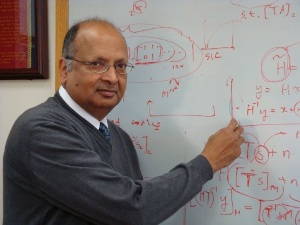Jan 24 2014
Professor (Emeritus) Arogyaswami Joseph Paulraj, Stanford University, has been awarded the prestigious 2014 Marconi Society Prize. His idea for using multiple antennas at both the transmitting and receiving stations - which is at the heart of the current high speed WiFi and 4G mobile systems - has revolutionized high speed wireless delivery of multimedia services for billions of people.
 Stanford Professor (Emeritus) A. J. Paulraj, inventor of MIMO technology widely used in mobile devices, has won the 2014 Marconi Prize (Photo: Business Wire)
Stanford Professor (Emeritus) A. J. Paulraj, inventor of MIMO technology widely used in mobile devices, has won the 2014 Marconi Prize (Photo: Business Wire)
“Paulraj’s contributions to wireless technology, and the resulting benefit to mankind, are indisputable. Every WiFi router and 4G phone today uses MIMO technology pioneered by him,” says Vint Cerf, Vice Chairman of the Marconi Society.
The Marconi Society, celebrating its 50th year in 2014, was founded by Gioia Marconi Braga. Each year it recognizes one or more scientists who - like her father, radio inventor Guglielmo Marconi – pursue advances in communications and information technology for the social, economic and cultural development of all humanity. Winners, who receive a $100,000 prize, have included scientists whose mathematical theories and inventions have shaped the Internet and broadband access, public key encryption, Web search, wired and wireless transmission, multimedia publishing, optical fiber and satellite communications.
Paulraj’s story is a remarkable one. A native of India, a brilliant top ranking student, he finished high school at 15 and joined the Indian Navy where his training focused on practical skills for maintaining weapons systems. But, Paul (as he is commonly known) taught himself subjects like information theory and signal processing. This finally led to a Ph.D. from Indian Institute of Technology (Delhi), for work on non-linear estimation theory. In 1977, the Navy assigned him to lead an ambitious project to develop advanced sonars. Overcoming difficult circumstances, his team developed a world-class sonar system (APSOH) that was inducted into fleet service in 1983, a stunning achievement in military electronics for India.
On sabbatical leave following his APSOH work, Paul managed to get a slot in Prof. Thomas Kailath’s research group at Stanford. There, he worked on a multiple signals Directions of Arrival (DOA) estimation problem. He soon invented a striking new method called ESPRIT leading to a mini-revolution in this field.
Paul returned to India in 1986 and served as the founding director for three major labs in India. But by 1991, bureaucratic battles began to take their toll and he returned to Stanford University. Back at Stanford, he worked on signal separation experiments for airborne reconnaissance. This led to an idea called Spatial Multiplexing for increasing throughput in wireless systems using multiple transmit and receive antennas (MIMO - Multiple Input, Multiple Output). Paul applied for an U.S. patent in Feb. 1992 but his ideas faced considerable skepticism in the early days.
Undaunted, he founded Iospan Wireless Inc. to develop a MIMO-OFDMA based fixed wireless system. Intel Corp. acquired Iospan’s technology in 2003, using it to spearhead the WiMAX standards. In 2004, Paulraj co-founded Beceem Communications to develop WiMAX semiconductors and the company emerged as a market leader and was acquired by Broadcom Corp.
Stanford colleague and Marconi Fellow, Prof. John Cioffi, the inventor of the DSL technology, calls Paul’s technical capability “almost unparalleled in the world. But what impresses me most is how Paul endured the tremendous pressure, turmoil and stress of people saying his ideas weren’t going to work, and persevered until he found success. Such people are pretty rare.”
With characteristic modesty, Paul says, “MIMO technology is today embedded in 4G mobile and WiFi. It has taken the effort of thousands of engineers and researchers around the world, many of them truly eminent, to make this happen. My contribution, in comparison, is indeed small.”
Paul was elected to the US National Academy of Engineering (NAE) in 2006, and to several national academies around the world. He received the Padma Bhushan, a major Indian award, in 2010 and the IEEE Alexander Graham Bell Medal in 2011. Paul says, “The Marconi Prize that emphasizes service to humanity is the highest recognition I can imagine.”
Paul remains active with post-doc students at Stanford and as a Senior Adviser to Broadcom Corp. He lives on the Stanford campus with his wife Nirmala. “I have two grown children and four wonderful grandchildren,” says Paulraj. “My biggest challenge is finding time for all the things I want to do.”
About the Marconi Society
Additional information about the Marconi Society and the Marconi Fellows can be found at www.marconisociety.org.